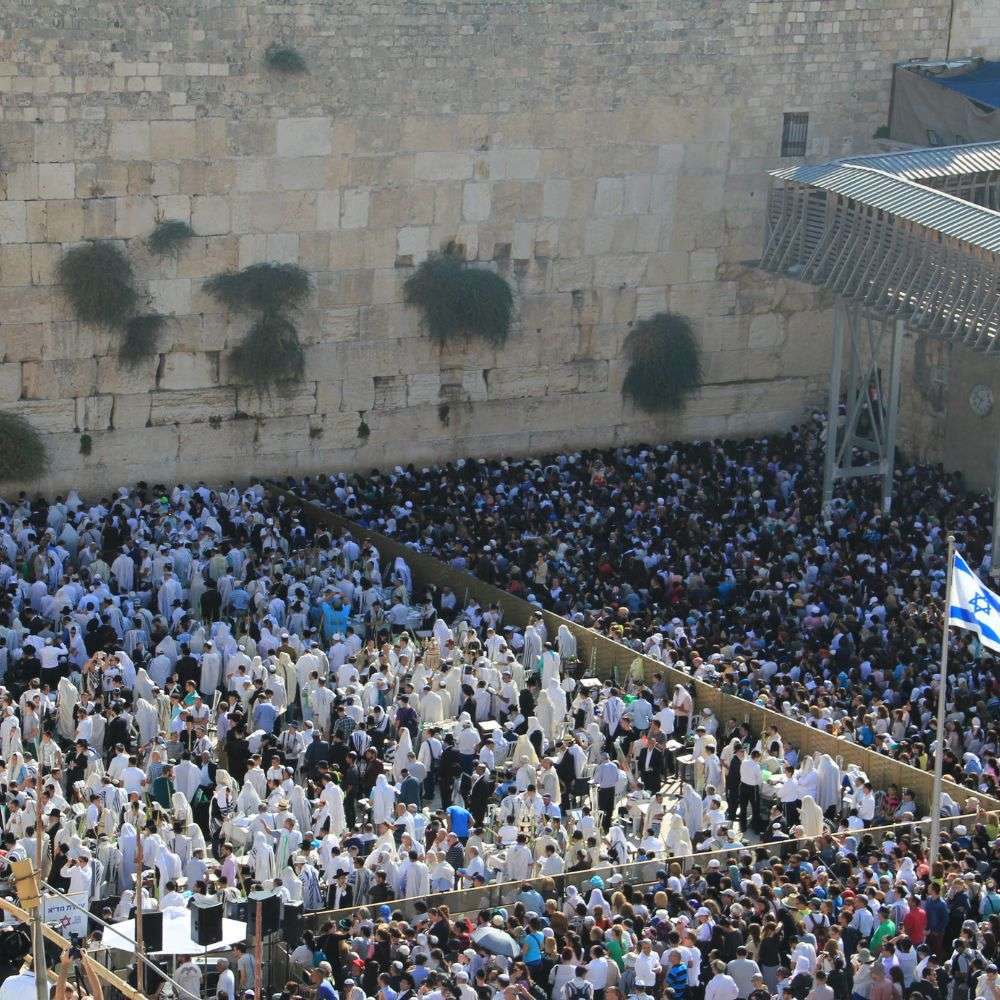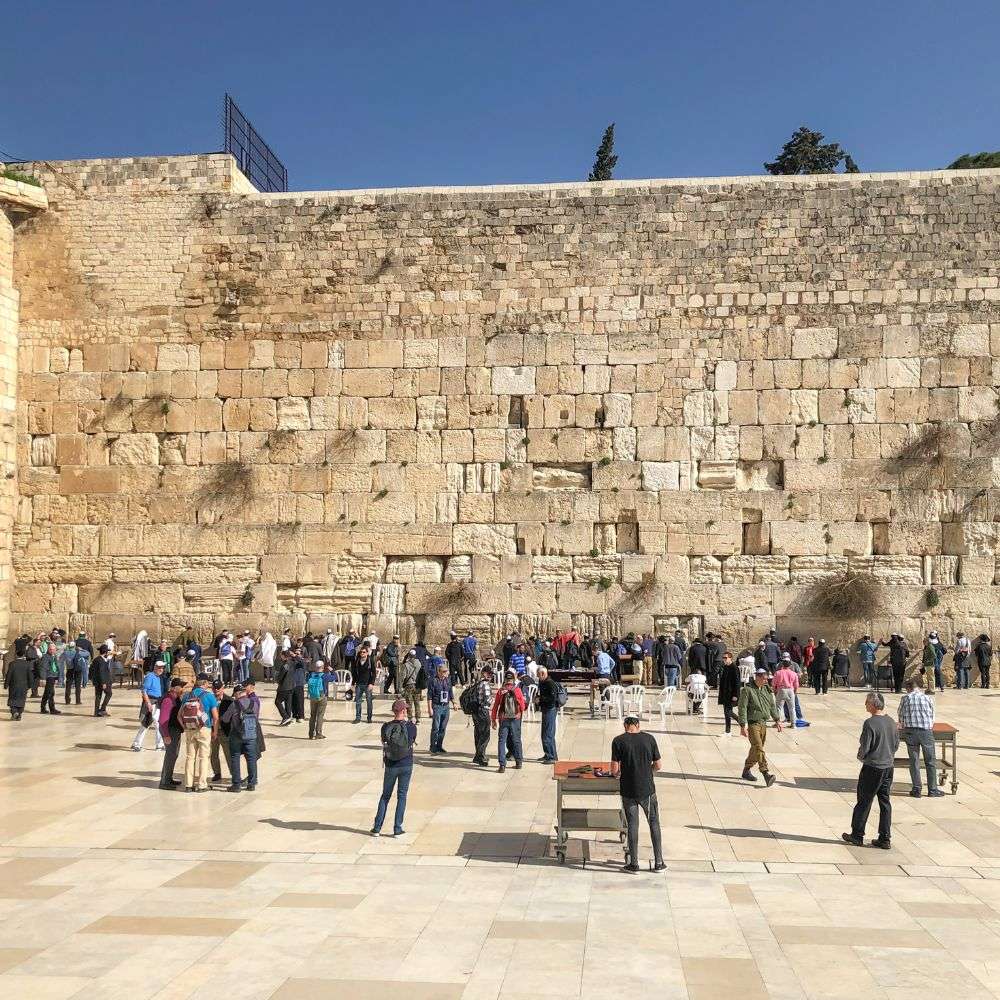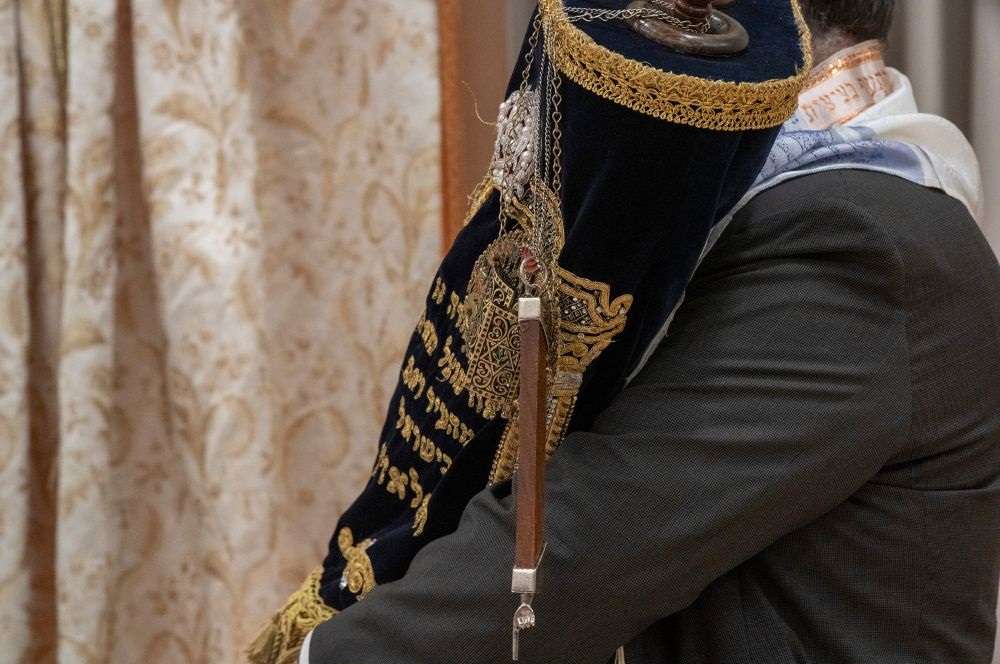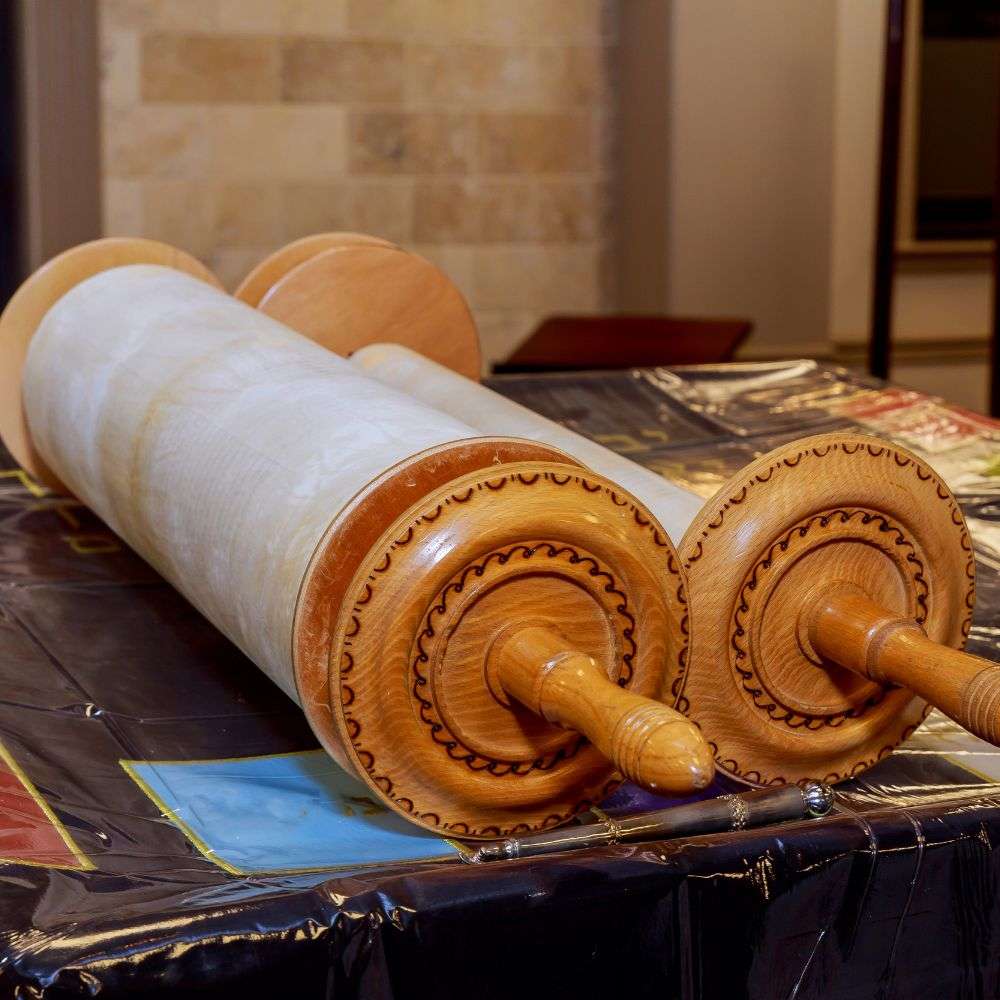Definition
Simchat Torah, which means “Joy of the Torah” in Hebrew, is a joyous holiday celebrated by Jewish communities around the world. It marks the end of the annual cycle of reading the Torah, the sacred text of Jewish tradition, and the beginning of a new cycle. Simchat Torah is typically observed on the day after Shemini Atzeret, which is the eighth day of the Sukkot festival. This special holiday is filled with dancing, singing, and a festive atmosphere as the Jewish community comes together to celebrate the completion of the Torah and to start reading it again from the beginning. It is a time of great rejoicing and gratitude for the gift of the Torah, the central foundation of Jewish life and identity. The day is also marked by the recitation of prayers for rain, symbolic of the upcoming rainy season in Israel, as well as the priestly blessing and the reading of a unique portion from the Torah. Simchat Torah is a beautiful holiday season that brings people together, strengthens community bonds, and highlights the importance of Jewish traditions and values.
History
Simchat Torah, also known as Shemini Atzeret, has a rich history that dates back to ancient times. The origins of this joyous holiday can be traced to the Talmudic period. In the Talmud, Shemini Atzeret was referred to as a separate holiday observed on the eighth day of Sukkot. It marked the conclusion of the annual cycle of Torah readings.
During the Rishonic period, the name Simchat Torah came into use. This name emphasized the celebration of the Torah, with festivities centered around the completion and restarting of the reading cycle. This change in name signified a shift in focus to the joyful aspects of the holiday.
Significant customs and practices arose during the Rishonic period, further shaping the observance of Simchat Torah. These included congregational blessings, aliyah blessings, and the reading of Genesis 48:16, where Jacob blesses his grandsons, Ephraim and Menashe. These customs have evolved over time and vary among different Jewish communities.
Simchat Torah is now widely celebrated as a beautiful holiday season, often referred to as the “blockbuster” holiday of the fall. It is a day of rejoicing that embodies Jewish identity and tradition. Synagogues, both conservative and Hasidic, hold festive services where the entire community actively participates. It is a fun-filled holiday, especially for children, who often take part in parading around the synagogue with colorful flags and eating traditional treats like potato pancakes.
In conclusion, Simchat Torah has a long and vibrant history, reflecting the deep connection of Jewish communities to their sacred texts. The holiday has evolved over time, incorporating various customs and practices that enhance the joyous celebration of the annual cycle of Torah readings.
Observance
Simchat Torah is observed by Jewish communities around the world with great joy and enthusiasm. This annual holiday, also known as the “Joy of Torah,” marks the completion and restarting of the cycle of readings from the Torah. It is a time of celebration and gratitude for the Jewish people and their connection to their sacred scripture.
During Simchat Torah, special services are held both during the day and evening in synagogues. These services are characterized by lively singing, dancing, and the reading of the final portion of the Torah, followed immediately by the beginning of Genesis. This continuous reading symbolizes the unending nature of Jewish learning and the cyclical nature of Jewish life.
Customs and traditions associated with Simchat Torah vary among different Jewish communities. In some synagogues, congregational blessings and aliyah blessings, where individuals are called up to read from the Torah, are observed. The reading of Genesis 48:16, where Jacob blesses his grandsons, Ephraim and Menashe, is also a common practice.
Simchat Torah is a day of pure joy and celebration. It brings together Jewish communities to rejoice in the Torah and express their love for Jewish tradition and identity. This special holiday holds a significant place in the annual Jewish calendar and is eagerly anticipated as a time of renewal and inspiration.
Significance of Simchat Torah
Simchat Torah, meaning “Joy of the Torah” in Hebrew, is a joyous holiday celebrated by Jewish communities around the world. It marks the conclusion of the annual cycle of Torah readings and the immediate beginning of a new cycle. This special holiday holds deep meaning in Jewish life as it symbolizes the unending nature of Jewish learning and the cyclical nature of Jewish tradition. Simchat Torah is a time of great celebration, where synagogues come alive with singing, dancing, and festivities. In addition to reading the final portion of the Torah and immediately starting again from the beginning, various customs and traditions are observed, such as congregational blessings, aliyah blessings, and the recitation of specific biblical passages. Simchat Torah holds a significant place in Jewish identity, as it is a time for communities to come together, express their love for the Torah, and reinforce their commitment to the study and observance of Jewish values in the year to come.
Connection to the Annual Cycle
Simchat Torah holds great significance in Jewish communities as it is intricately connected to the annual cycle of Torah readings. This joyous holiday marks the completion of the reading of the Torah scrolls, which occurs throughout the year. Jewish communities diligently follow the annual cycle, reading a specific portion of the Torah each week, until they reach the end of Deuteronomy. Simchat Torah then immediately restarts this cycle, emphasizing the ongoing nature of Jewish learning and spirituality.
The completion of the annual reading is a cause for celebration, as it symbolizes the commitment to Jewish tradition and the passing down of knowledge from one generation to another. As Jewish festivals and holidays precede Simchat Torah, including Rosh Hashanah, Yom Kippur, and Sukkot, this joyous holiday concludes the entire fall holiday season. It serves as a beautiful finale to this blockbuster holiday period, embodying the essence of Jewish identity and the deep connection to religious traditions.
Simchat Torah is celebrated with fervor and enthusiasm in Jewish communities around the world. Individuals gather in synagogues during the evening and participate in individual synagogue customs, such as dancing with the Torah scrolls, singing festive songs, and sharing in the communal joy. This holiday serves as a reminder of the intricate connection between the Jewish people and the words of the Torah, ensuring that the annual cycle of readings continues to be a cherished and integral part of Jewish life.
Joyous Holiday Celebrating Judaism and Jewish Identity
Simchat Torah is a joyous holiday that holds deep significance in Judaism and celebrates Jewish identity. It marks the completion of the annual cycle of public Torah readings and is a time of celebration and unity within the Jewish community.
During the holiday, Jewish communities come together in synagogues around the world to rejoice and honor the Torah, the sacred text that guides Jewish life. This festive occasion fosters a sense of connection to Jewish traditions and strengthens Jewish identity.
Customs and traditions associated with Simchat Torah include lively processions around the Torah scrolls, singing and dancing with them, and even parades through the streets. The Torah is read aloud, and participants of all ages have the opportunity to carry the Torah and receive an aliyah blessing. Children, in particular, are given a special role during the holiday, highlighting the importance of passing down Jewish traditions to future generations.
Simchat Torah is a time of joy and enjoyment, speaking to the heart of Jewish identity. It showcases the vibrancy and resilience of Jewish communities and highlights the deep-rooted commitment to the annual cycle of Torah readings. This joyous holiday not only celebrates the completion of the readings but also strengthens the bond among Jews worldwide and reinforces their connection to their religious heritage.
Prayer for Rain and Priestly Blessing
Simchat Torah, the joyous holiday which marks the culmination of the annual reading of the Torah, holds significant rituals that are observed in Jewish communities worldwide. One of these rituals is the Prayer for Rain, known as Tefilat Geshem.

The Prayer for Rain is recited during the Musaf service on Simchat Torah, which follows the morning prayer service, Shacharit. This prayer acknowledges the importance of rain for agricultural prosperity and is especially significant as it falls during the start of the rainy season in Israel. Jewish tradition teaches that the blessing of rain is essential for the growth of crops and sustenance, symbolizing God’s abundance and provision. Therefore, the Prayer for Rain on Simchat Torah serves as a reminder to align oneself with the cycles of nature and to express gratitude for the sustenance it provides.
Another central aspect of Simchat Torah is the Priestly Blessing, known as Birkat Kohanim. In most Eastern Ashkenazic communities, this blessing is performed as part of the Shacharit service before the festivities connected with the Torah reading begin. The Priestly Blessing is based on the ancient biblical command for the Kohanim, the priestly descendants of Aaron, to bless the Jewish people. The Kohanim, hands raised and fingers separated in a specific formation, recite the words of blessing from the book of Numbers (6:24-26). This blessing symbolizes the connection between the divine and the congregation, and it is believed to impart divine protection and favor upon those receiving it.
The inclusion of the Prayer for Rain and the performance of the Priestly Blessing enhance the spiritual depth and significance of Simchat Torah. These rituals connect Jewish communities to their agricultural roots, deepen their connection to the divine, and reinforce their commitment to Jewish traditions.
Customs and Traditions Associated with Simchat Torah
Simchat Torah is a joyous Jewish holiday celebrated at the end of the annual cycle of Torah readings. It is a time for Jewish communities to come together, rejoicing in the completion of the Torah and starting the cycle anew. This festive holiday is filled with customs and traditions that add meaning and significance to the celebration. From the recitation of the Prayer for Rain, which acknowledges the importance of agricultural prosperity, to the Priestly Blessing, which symbolizes the divine connection with the congregation, Simchat Torah is a time to express gratitude, seek blessings, and strengthen Jewish identity. In addition, individual synagogue customs, such as the congregational blessing and the reading of specific Torah portions, add unique elements to the celebration. Simchat Torah is a beautiful holiday season that encompasses a spirit of joy, community, and renewal.

Ordinary Holiday Morning Service
During the ordinary holiday morning service on Simchat Torah, Jewish communities come together to celebrate this joyous holiday. The service includes several special components that mark the significance of this day in the annual cycle of readings.
One highlight of the service is the special holiday Amidah, a central prayer that is recited by the congregation. This prayer is specifically tailored for Simchat Torah and expresses gratitude for the annual completion of the Torah reading cycle.
Another essential element is the saying of Hallel, a collection of psalms that are recited to praise and thank God. Hallel is sung with great enthusiasm to commemorate the completion of the Torah readings and the start of a new cycle.
The service also features a holiday Mussaf service, which includes additional prayers and blessings that are unique to this day. These prayers further emphasize the significance of Simchat Torah as a joyous and sacred occasion.
When the ark is opened to take out the Torah for the Torah reading, all the scrolls are again removed from the ark. This marks the beginning of the seven hakafot, which are similar to the evening service. The congregation joyously dances and parades with the Torah scrolls around the synagogue, celebrating the completion and restarting of the Torah readings.
The ordinary holiday morning service during Simchat Torah is a beautiful holiday season filled with prayer, song, and a deep sense of Jewish identity and tradition. It is a time when Jewish communities come together to rejoice in the completion of another cycle of readings and to renew their commitment to Jewish life.
Special Holiday Evening Service
The special holiday evening service associated with Simchat Torah is a joyous and vibrant celebration that takes place in Jewish communities around the world. It is a time to commemorate the completion of the annual reading of the Torah and the beginning of a new cycle.
During this service, the Torah scrolls are taken out of the ark and all the scrolls are removed. This symbolizes the restart of the Torah readings. It is a moment of great significance as the community gathers around the Torah scrolls, embracing the sacred text that is at the heart of Jewish tradition.
One of the most beloved customs during this service is the hakafot, where the congregation joyously dances and parades with the Torah scrolls around the synagogue. It is a beautiful display of unity and celebration, as people of all ages participate in the festivities.
The evening service also includes heartfelt prayers, songs, and blessings, expressing gratitude for the completion of the reading cycle and anticipation for the year ahead. This service is a testament to the Jewish community’s deep connection to their heritage and the joy that is associated with studying and embracing the teachings of the Torah.
Simchat Torah’s special holiday evening service is a time of celebration, unity, and renewal, as Jewish communities come together to honor and rejoice in the beauty and wisdom of the Torah.
Seven-Day Festival of Rejoicing
The Seven-Day Festival of Rejoicing, also known as Simchat Torah, is a joyous and significant holiday in the Jewish calendar. It marks the completion of the annual reading of the Torah scrolls, which is a milestone in Jewish tradition.
During this celebratory time, Jewish communities come together to express their joy and gratitude for the teachings of the Torah. The completion of the reading cycle is a moment of great significance, symbolizing the continuous cycle of learning and spiritual growth in Jewish life.
One of the cherished customs during Simchat Torah is the congregational blessing. Members of the community stand together, arm in arm, symbolically joining in the blessings that are recited over the Torah. This act of unity reinforces the importance of togetherness and shared celebration.
Another important tradition associated with Simchat Torah is the aliyah blessing. Members of the congregation are called up to the bimah, the elevated platform in the synagogue, to participate in the reading of the final portion of the Torah. This practice highlights the democratic nature of Jewish worship, where everyone has the opportunity to engage with the sacred text.
The observance of Simchat Torah varies among different Jewish communities. Conservative synagogues often engage in lively singing and dancing, while Hasidic communities may have additional customs and practices unique to their traditions. Regardless of the specific customs, the emphasis always remains on the joy and celebration that comes from the completion of the annual reading.
In conclusion, the Seven-Day Festival of Rejoicing or Simchat Torah is a time of great celebration and significance for Jewish communities around the world. It symbolizes the completion of the annual reading of the Torah scrolls and emphasizes the importance of community participation in the observance of Jewish traditions and customs.
Two-Day Festival of Shemini Atzeret/Simchat Torah
The Two-Day Festival of Shemini Atzeret/Simchat Torah holds special significance in Jewish tradition as the follow-up to Sukkot, the festival of booths. After the joyful celebrations of Sukkot, the focus shifts to Shemini Atzeret and Simchat Torah, marking the completion of the annual cycle of Torah readings.
In Israel, the festival is observed as a single day, known as Shemini Atzeret. However, outside of Israel, it expands to a two-day celebration, with the second day dedicated specifically to Simchat Torah.

During Simchat Torah, Jewish communities gather to express their heartfelt joy and gratitude for the teachings of the Torah. The completion of the annual reading cycle is a momentous occasion, symbolizing the continuous cycle of learning and spiritual growth within Jewish life.
By observing the Two-Day Festival of Shemini Atzeret/Simchat Torah, Jewish individuals and communities reaffirm their commitment to the study and observance of the Torah. It is a time of celebration, unity, and dedication to the values and teachings that form the foundation of Jewish identity.
In summary, Shemini Atzeret and Simchat Torah are celebrated as a follow-up to Sukkot and mark the completion of the annual cycle of Torah readings. This two-day festival allows Jewish communities outside of Israel to rejoice in the joyous celebration of Simchat Torah.
Annual Reading of the Torah Scrolls
The Annual Reading of the Torah Scrolls is a central focus of the joyous holiday of Simchat Torah. On this special day, Jewish communities come together to celebrate the completion of the annual cycle of Torah readings and the immediate start of a new cycle. It is a time of immense gratitude and unity as everyone rejoices in the teachings and wisdom of the Torah.

The culminating parashah of the Torah, known as V’Zot HaBerachah, marks the end of the reading cycle. Immediately following this, the first chapter (and part of the second) of the Book of Genesis is read, symbolizing the seamless renewal of the cycle of learning.
During the Simchat Torah service, there are specific honors bestowed upon individuals who are called to the Torah for the last aliyah of Deuteronomy, known as Hatan Torah, and the first aliyah of Genesis, known as Hatan B’reishit. These individuals are recognized for their dedication to the study and observance of the Torah, and their participation in the annual reading is a moment of great honor and significance.
Simchat Torah is a time of immense joy and celebration, as Jewish communities come together to express their deep appreciation for the Torah. It is a beautiful holiday season filled with blessings, prayers, and the renewal of commitment to Jewish traditions and values.
Keywords: Simchat Torah, Torah scrolls, annual reading, last parashah, Book of Genesis. (199 words)
Stuffed Cabbage and Classic Kreplach
Stuffed Cabbage, also known as Holishkes or Prakas, are a traditional and beloved food associated with Sukkot and Simchat Torah, a festive holiday in Jewish culture. These delicious stuffed cabbage hold great significance and are enjoyed by Jewish communities around the world during this joyous occasion.
Why do we eat stuffed cabbage on Simchat Torah?
Created by encasing minced meat in blanched cabbage leaves and gently simmering them in a tomato sauce, this dish often incorporates rice into the meat mixture. Although it can be enjoyed throughout the year, it is particularly associated with Sukkot as a symbol of a fruitful harvest. Additionally, it is served on Simchat Torah, as the two stuffed cabbage rolls, positioned next to each other, resemble Torah scrolls.

What Are Kreplach?
Kreplach, with their Yiddish name “קרעפּלעך” (Kreplekh), are petite dumplings that boast a filling of ground meat, mashed potatoes, or other options. These dumplings are commonly boiled and served in chicken soup, although they can also be enjoyed when fried. Their culinary kinship extends to Polish pierogi, Polish and Ukrainian uszka, Russian pelmeni, Italian ravioli or tortellini, German Maultaschen, and Chinese jiaozi and wonton.

The dough for kreplach traditionally consists of a blend of flour, water, and eggs, which is skillfully kneaded and rolled out until thin. In modern times, some cooks opt for the convenience of frozen dough sheets or wonton wrappers for their preparations. Additionally, pre-made kreplach can be conveniently found in the kosher freezer section of supermarkets for those seeking a ready-made option.
Simchat Torah brings communities together, and the sharing of traditional foods like potato pancakes reinforces the sense of unity and joy that permeates this special holiday. As families and friends gather to celebrate, the enjoyment of these festive dishes becomes a part of the cherished traditions that strengthen Jewish identity and create lasting memories.
Recommend0 recommendationsPublished in Daily Learning, Opinion
Responses